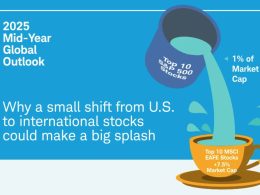2018 Investment Outlook: All signs point towards a sustained global expansion
We approach the new year with confidence that the world’s leading economies will continue to display strength and resilience. The U.S. economy is likely to lead from the front, aided by a gathering upturn in the eurozone and the start of a renewed upswing in global trade. The likely expansion among developed economies should also have a positive impact on the export-oriented, manufacturing economies of East Asia as well as commodity producers in other emerging nations.
United States
A strong labour market (the unemployment rate fell to 4.2% in September – a 16-year low) and benign inflation are likely to underpin moderate real GDP growth in 2018. I expect the U.S. economy to expand by 2.2% in real terms in 2018.
For most of 2017, inflation has undershot the U.S. Federal Reserve’s (Fed) target. Fed governors and presidents have attributed this to one-off reductions in cellular phone contract prices and other exceptional events, asserting that the underperformance of inflation relative to the 2% target is “transitory.” However, after several months of price weakness, the claim that these price changes are temporary is starting to lose credibility. A key moment will come in the spring of 2018, when 2017’s price declines will fall out of the year-on-year comparison. My view is that the underlying problem is slow growth of money and credit. However, I expect no great harm to come from this modest degree of price weakness provided that core inflation starts to pick up again in 2018.
Against this backdrop, the Fed has continued with its policy of gradually normalizing – not tightening – interest rates, and in September 2017 the central bank announced the start of a plan to shrink its balance sheet following the scheme. The “dot plot” released with the Federal Open Market Committee statement suggested another possible interest rate hike in December 2017 plus three further hikes of 0.25% in 2018. This would take the federal funds rate to a range of 2.0% to 2.25% by the end of 2018.
The plan to shrink the Fed’s balance sheet is intended to gain momentum in 2018. Initially, the runoff will start at $10 billion per month during the fourth quarter of 2017, but is envisaged to rise to $50 billion per month in the final quarter of 2018. This means that private sector investors will need to replace the Fed as a holder of these securities, and therefore the U.S. Treasury and government agencies will need to increase auction sizes accordingly. Selling an additional $50 billion of debt securities per month risks raising long-term interest rates, tightening financial conditions, and squeezing bank credit and money growth. In my view, the Fed will need to proceed with caution.
There is good reason to expect the current expansion in the U.S. has further to go and could actually become the longest business cycle expansion in U.S. financial history. This would imply a continuous upswing that exceeds the record trough-to-peak expansion of 120 months between March 1991 and March 2001 (as measured by the National Bureau of Economic Research). The only real threat to this prospect is the possibility that the Fed and other central banks could make a mistake and tighten too much during monetary policy normalisation. If they overdo the tightening, there is a real risk of a slowdown in 2018-2019 and a continuation of below-target inflation rates across many major economies. This is not my base case, but investors need to be mindful of this possibility.
Eurozone
Economic activity in the eurozone is at last expanding at a momentum close to its potential. This is largely a result of the asset purchase programme started by the European Central Bank (ECB) in March 2015 and the associated acceleration of the money supply (M3). To ensure that economic momentum is sustained, commercial banks need to create credit more rapidly than at present. Otherwise, when the ECB starts to taper its purchases, credit growth could weaken substantially.
Even though the economies of the single currency area may have recovered, the basis for sustained M3 growth of 5% or more in the eurozone – which I believe to be the minimum needed to ensure 2% real growth and 2% inflation after allowing for a 1% annual decline in income velocity (or the turnover of money relative to income) – is distinctly fragile. The risk, therefore, is that tapering quantitative easing purchases will lead to a renewed and damaging slowdown in M3 growth, resulting in the inflation rate declining further beneath its target of “below but close to 2%”. I expect inflation to remain below its target figure for the year ahead due to inadequate M3 growth.
United Kingdom
U.K. economic growth picked up a little in the third quarter of 2017 after a sluggish first half, but still remains below its recent trend. However, the British economy is likely to draw support over the next 12 months by buoyant elements of consumer and business spending. Going forward, I expect growth to hold up for two reasons. Firstly, monetary policy has been highly stimulatory, and secondly, the weaker pound has enabled the manufacturing export sector to be much more vigorous than expected. The U.K. labour market also appears to be in good health – the economy continues to generate good job growth, the unemployment rate is very low and the participation rate is at a record high. However, as of October 2017, there were clear signals from the Bank of England that an interest rate hike would be coming (probably at the November 2017 meeting of the Monetary Policy Committee). In addition to imported inflation, there is a danger that accelerating money and credit expansion in the U.K. could add locally generated inflation to rising import prices. I expect growth to settle around 1.5% until the uncertainties of the Brexit negotiations are overcome.
Japan
The Japanese economy has had a decent run lately with real GDP increasing for six consecutive quarters, the first such extended stretch of growth for over a decade. While the labour market should remain tight in 2018, low wage growth is expected to persist, providing further evidence that the Phillips curve1 is not a dependable theory of inflation. Despite huge qualitative and quantitative easing (QQE) by the Bank of Japan, inflation is likely to stay weak and below the central bank’s 2% target, but should stay above zero. Economic growth for 2018 should remain stable (around 1.2%) but lag the U.S. and eurozone.
China and Emerging Asia
Both China and emerging Asia are likely to draw support from a modest increase in global trade. While this should help underpin commodity prices, I don’t believe it will be enough to translate into a commodity boom next year. Since China is by far the largest emerging market and also the biggest buyer of commodities on world markets, the growth of China’s imports matters immensely to numerous developed and emerging commodity exporters around the world. If China can engineer a steady domestic recovery over the next year or two, the outlook for those commodity-exporting economies will improve considerably. However, in light of the continuing moderate recovery in developed western economies, China’s upswing may not be sufficiently vigorous to drive a recovery in all commodity-producing economies.
This post was originally published at Invesco Canada Blog
Copyright © Invesco Canada Blog















